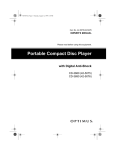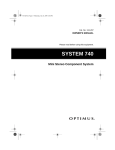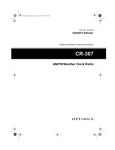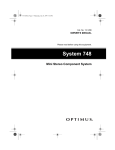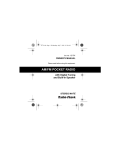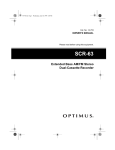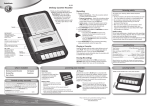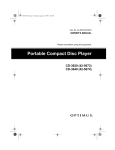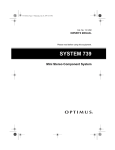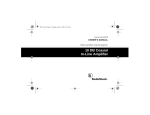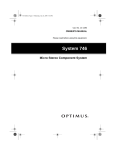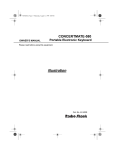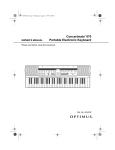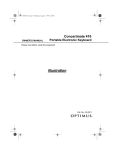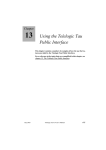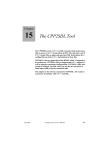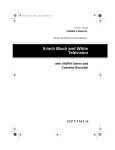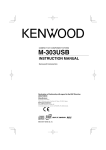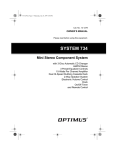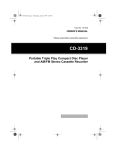Download Optimus SYSTEM 747 User's Manual
Transcript
13-1295.fm Page 1 Wednesday, July 14, 1999 7:10 PM Cat. No. 13-1295A OWNER’S MANUAL Please read before using this equipment. System 747 Mini Stereo Component System 13-1295.fm Page 2 Wednesday, July 14, 1999 7:10 PM FEATURES Your Optimus System 747 Mini Stereo Component System offers all the versatile features you need for excellent stereo sound and entertainment, all in one compact package. The system includes a top-loading 3disc carousel CD player with 32-track programmable memory, an AM/FM stereo tuner, a cassette player with auto-stop, and two 2-way speakers with 5-inch woofers and piezo tweeters. Its extended bass system lets you hear powerful, heavy bass while listening to the radio, a CD, or a cassette tape. Audible Search æ lets you quickly locate a particular section of a track while it is playing. Repeat Play æ repeats a single track, all tracks on a single CD, all CDs in the CD compartment, or a programmed sequence. Random Play æ plays all the loaded CD’s tracks in random order. Programmable Play — lets you program up to 32 selections (tracks or CDs) to play in any order you choose. Cassette Player The system’s features include: CD Player Multiple Source Recording — lets you record onto a cassette tape from either the CD player or the radio. Eight-Times Oversampling — improves the CD’s sound by multiplying the standard 44.1 kHz sampling rate by eight and using a digital filter to reduce or eliminate high-frequency distortion. Auto-Stop — protects the tape and tape-handling parts by automatically stopping the tape when it reaches the end. 1-Bit DAC — uses the latest in digitalto-analog conversion circuitry to accurately reproduce all sound levels with virtually no distortion. Automatic CD Changer æ lets you load and play up to three CDs. Automatic Skip æ lets you quickly locate and play any track on the loaded CDs. Important: Most material on compact discs and prerecorded tapes is copyrighted. Unauthorized duplication of copyrighted material is a violation of the copyright laws of most countries and such duplication may result in fines and/or imprisonment. Note, however, that in the United States, it is not a violation of U.S. copyright laws for a consumer to use an audio recording device to duplicate musical recordings for noncommercial (personal) use. © 1997 Tandy Corporation. All Rights Reserved. RadioShack and Optimus are registered trademarks used by Tandy Corporation. 2 13-1295.fm Page 3 Wednesday, July 14, 1999 7:10 PM Compact discs that you can play on your system’s CD player have this mark on them: Warning: This system uses a laser light beam. Only a qualified service person should remove the cover or attempt to service this device, due to possible eye injury. We recommend you record your system’s serial number here. The number is on the back panel. Serial Number: ________________ Warning: To prevent fire or shock hazard, do not expose this product to rain or moisture. CAUTION RISK OF ELECTRIC SHOCK. DO NOT OPEN. ! CAUTION: TO REDUCE THE RISK OF ELECTRIC SHOCK, DO NOT REMOVE COVER OR BACK. NO USER-SERVICEABLE PARTS INSIDE. REFER SERVICING TO QUALIFIED PERSONNEL. This symbol is intended to alert you to the presence of uninsulated dangerous voltage within the product’s enclosure that might be of sufficient magnitude to constitute a risk of electric shock. Do not open the product’s case. ! This symbol is intended to inform you that important operating and maintenance instructions are included in the literature accompanying this product. The graphical symbols with supplemental markings are located on the back of the system. Warning: The use of controls, adjustments, or procedures other than those specified herein may result in hazardous radiation exposure. FCC INFORMATION This system complies with the limits for a Class B digital device as specified in Part 15 of FCC Rules. These limits provide reasonable protection against TV or radio interference in a residential area. However, your system might cause TV or radio interference even when it is operating properly. To eliminate interference, you can try one or more of the following corrective measures. • Reorient or relocate the TV or radio’s receiving antenna. • Increase the distance between the system and the TV or radio. • Use outlets on different electrical circuits for the system and the TV or radio. Consult your local RadioShack store if the problem still exists. 3 13-1295.fm Page 4 Wednesday, July 14, 1999 7:10 PM CONTENTS Preparation ........................................................................................................... 5 Connecting the Speakers ................................................................................ 5 Connecting the FM Antenna ............................................................................ 5 Connecting to Power ....................................................................................... 5 Using Headphones .......................................................................................... 6 Listening Safely ......................................................................................... 6 Basic Operation ................................................................................................... 7 Tuner Operation ................................................................................................... 8 CD Player Operation ............................................................................................ 9 Loading a CD ................................................................................................... 9 Playing a CD .................................................................................................... 9 Selecting Another CD .................................................................................... 10 Automatic Skip ............................................................................................... 10 Audible Search .............................................................................................. 11 Random Play ................................................................................................. 11 Repeat Play ................................................................................................... 12 Programmed Play .......................................................................................... 12 Programming and Playing a Sequence of Tracks ................................... 12 Reviewing the Programmed Sequence .................................................. 13 Erasing the Programmed Sequence ....................................................... 13 CD Care Tips ................................................................................................. 13 Cassette Deck Operation .................................................................................. Loading a Cassette Tape ............................................................................... Playing a Cassette Tape ................................................................................ Recording on a Cassette Tape ...................................................................... Recording from a CD .............................................................................. Recording from the Tuner ....................................................................... Tape Care Tips .............................................................................................. Preventing Accidental Erasure ................................................................ Erasing a Cassette Tape ......................................................................... Restoring Tape Tension and Sound Quality ............................................ 15 15 15 16 16 17 17 17 18 18 Care and Maintenance ....................................................................................... 19 Cleaning the Tape Handling Parts ................................................................. 20 Specifications ..................................................................................................... 21 4 13-1295.fm Page 5 Wednesday, July 14, 1999 7:10 PM PREPARATION Note: Complete all other connections before connecting the system to AC power and turning it on. CONNECTING THE SPEAKERS CONNECTING THE FM ANTENNA Attach the supplied FM antenna to the 300-ohm FM ANTENNA terminal on the back of the system. show FM ANTENNA terminal show SPEAKER terminals on back of system 1. Press the red speaker terminal tab labeled SPEAKER R + on the back of the system, put the stripped end of the right speaker’s striped wire into the terminal, then release the tab. 2. Press the black speaker terminal tab labeled SPEAKER R - on the back of the system, put the stripped end of the right speaker’s other wire into the terminal, then release the tab. 3. Repeat Steps 1 and 2 to connect the left speaker to the SPEAKER L + and - terminals. Note: If you have an outside VHF TV antenna, you can use a signal splitter with a 300-ohm output to connect your stereo system and TV set to the same antenna. Your local RadioShack store has a wide selection of antennas, connectors, and splitters. CONNECTING TO POWER After you complete all connections, plug the music system’s power cord into a standard AC outlet. STANDBY lights. show STANDBY indicator location 5 13-1295.fm Page 6 Wednesday, July 14, 1999 7:10 PM Warning: To prevent electric shock, the power cord plug’s blades are polarized and fit a polarized AC outlet only one way. If you have difficulty inserting the plug, do not force it. Turn it over and reinsert it. USING HEADPHONES You can use headphones (not supplied) to listen in privacy. Insert the headphones’ 1/8-inch (3.5 mm) plug into the jack. show location Notes: • Your local RadioShack store sells a wide selection of headphones. • Connecting headphones automatically disconnects the speakers. 6 Listening Safely To protect your hearing, follow these guidelines when you use headphones. • Do not volume volume manent listen at extremely high levels. Extended highlistening can lead to perhearing loss. • Set the volume to the lowest setting before you begin listening. After you begin listening, adjust the volume to a comfortable level. • Once you set the volume, do not increase it. Over time, your ears adapt to the volume level, so a volume level that does not cause discomfort might still damage your hearing. 13-1295.fm Page 7 Wednesday, July 14, 1999 7:10 PM BASIC OPERATION Warning: To protect your hearing, rotate VOLUME to the lowest sound level before you turn on the system. Follow these steps to operate your system. 4. Slide STEREO WIDE to ON to hear the sound equally from the left and right speakers. show STEREO WIDE location 1. Set FUNCTION to TAPE , TUNER, or CD . POWER ON lights. show FUNCTION switch location 5. Slide E-BASS to ON to emphasize bass sounds. To return to normal bass sounds, slide it to OFF. show E-BASS location 2. If you selected TUNER, see “Tuner Operation” on Page 8 for how to select a station. If you selected TAPE or CD, see “Cassette Deck Operation” on Page 15 or “CD Player Operation” on Page 9 for how to play a cassette tape or a CD. 6. To turn off the system, slide FUNCSTANDBY. TION to STANDBY lights. 3. Adjust VOLUME to a comfortable listening level. show VOLUME location 7 13-1295.fm Page 8 Wednesday, July 14, 1999 7:10 PM TUNER OPERATION 1. Slide FUNCTION to TUNER. show FUNCTION set to TUNER Note: When you select TUNER, the system automatically tunes to the station that was playing when the system was turned off or when it was last set to TUNER. 2. Set BAND to AM or FM to tune to AM or FM radio stations. show BAND set to FM 3. Use FM MONO/STEREO to select monaural or stereo sound. show FM MONO/STEREO set to STEREO • Slide FM MONO/STERO to STEREO to select stereo sound. FM STEREO lights when the tuner receives an FM broadcast in stereo. • If FM stereo reception is noisy, slide FM MONO/STERO to MONO to select monaural sound. The sound is no longer in stereo, but reception should improve. 4. Rotate TUNING to select the desired station. show TUNING location Notes: • The system uses a built-in ferrite antenna for AM reception. For the best AM reception, reposition the system. • For the best FM reception, see “Connecting the FM Antenna” on Page 5. 8 5. Adjust the volume and set E-BASS and STEREO WIDE for the desired sound. 13-1295.fm Page 9 Wednesday, July 14, 1999 7:10 PM CD PLAYER OPERATION LOADING A CD 1. Slide FUNCTION to CD. 4. After you load the CDs, close the CD compartment cover. The system displays the current tray number and the number of tracks on the CD in that tray. Notes: show FUNCTION set to CD • Track number 00 and the current tray number appear while the system checks each tray. • If no CDs are installed, no appears. 2. Lift the CD compartment cover. PLAYING A CD After loading a CD, follow these steps to play it. 1. Press PLAY/PAUSE Note: The CD carousel has three trays, each labeled with numbers, but only two trays are exposed when you open the CD compartment. . show PLAY/PAUSE location 3. Place a CD in either (or both) of the exposed trays, label side up. To load a CD in the third tray, press DISC SKIP. The carousel rotates, exposing the other tray. The CD in the current tray begins to play from Track 1. The system displays , the current tray number, and the CD’s current track number. Notes: show DISC SKIP location • If a tray does not contain a CD, the system skips that tray and automatically plays the CD in the next tray. 9 13-1295.fm Page 10 Wednesday, July 14, 1999 7:10 PM • During playback, if the changer is subjected to a sudden shock or jolt, the speed of rotation might change, or some noise might be produced. This is not a malfunction. 2. Adjust the volume and set E-BASS and STEREO WIDE for the desired sound. 3. To temporarily stop play, press PLAY/PAUSE . y appears. To PLAY/ resume play, press PAUSE again. AUTOMATIC SKIP The automatic skip feature lets you quickly locate the beginning of any track on a CD, including the track currently playing, and search forward or backward through the tracks. You can use automatic skip before or during play. show SKIP locations The system plays all the loaded CDs once, then stops. To stop play sooner, press STOP. show STOP location If a CD is playing: • Press SKIP once to skip to the beginning of the next track. once to skip back • Press SKIP to the beginning of the current track. SELECTING ANOTHER CD To select another CD, press DISC SKIP before or during play. If the system is playing a CD, it stops playing that CD and begins playing the first track on the selected CD. 10 to • Repeatedly press SKIP skip backward to the beginning of the desired track. to • Repeatedly press SKIP skip forward to the beginning of the desired track. If the CD is stopped or paused, repeatedly press SKIP or SKIP until the system displays the number of the track you want to play, then press PLAY/PAUSE . The CD player starts playing the selected track. 13-1295.fm Page 11 Wednesday, July 14, 1999 7:10 PM AUDIBLE SEARCH SEARCH or Hold down SEARCH to search forward or backward during play. The CD plays rapidly and you hear the music at a high speed and low volume. 3. Press PLAY/PAUSE . After one track plays, the system randomly selects another track and plays it, continuing until all tracks on all loaded CDs have played. Notes: • To repeat the current track, . To play the press SKIP next random track, press SKIP . show SEARCH locations RANDOM PLAY This feature randomly selects and plays tracks from all loaded CDs. • To repeat random play, before the last track ends, press REPEAT until REPEAT ALL appears. 4. To briefly stop random play, press PLAY/PAUSE y . y appears. To resume play, press it again. To stop random play, press STOP twice or press STOP then RANDOM. RANDOM disappears. Note: To randomly select tracks from only one or two CDs, you must load only those CDs in the CD tray. STOP to cancel any CD 1. Press function. 2. Press RANDOM. RANDOM appears. show RANDOM location 11 13-1295.fm Page 12 Wednesday, July 14, 1999 7:10 PM REPEAT PLAY PROGRAMMED PLAY You can repeat a single track on a selected CD, all tracks on a selected CD, all tracks on all loaded CDs, or a programmed sequence (see “Programmed Play” on Page 12). You can program up to 32 selections (tracks or CDs) from any loaded CDs to play in any order you choose. show REPEAT location STOP to cancel any CD 1. Press function. Programming and Playing a Sequence of Tracks 2. Press PROGRAM. You see: To repeat a single track, press REPEAT once while the desired track is playing. REPEAT ONE appears, and the CD player continuously replays the track. To repeat all tracks on a selected CD , press DISC SKIP to select the desired CD. Then repeatedly press REPEAT until REPEAT ONE DISC appears. To repeat a programmed sequence, press REPEAT until REPEAT ALL appears. The CD player continuously replays the programmed sequence. To repeat all tracks on all loaded CDs , repeatedly press REPEAT until REPEAT ALL DISC appears. To cancel repeat play at any time, repeatedly press REPEAT until REPEAT disappears. 12 3. Press DISC SKIP to select the CD containing the tracks you want to store. or SKIP to 4. Press SKIP select the track number you want to store, and press PROGRAM to store it. Or, press PROGRAM twice to store the entire CD as one selection. AL (all) appears after the CD number. 5. Repeat Steps 3–5 to program additional tracks. Note: You cannot store more than 32 tracks. Any track stored after the 32nd track replaces the 32nd track. 13-1295.fm Page 13 Wednesday, July 14, 1999 7:10 PM 6. Press PLAY/PAUSE to play the tracks in the programmed order. PROGRAM appears and the system displays the current tray and track number. Notes: or SKIP • You can use SKIP SEARCH or and SEARCH to move between selections during programmed play. • You cannot use random play while a programmed sequence is stored. • Pressing DISC SKIP has no effect while a programmed sequence plays. 7. Programmed play automatically stops at the end of the last programmed track. To stop the CD player at any time during programmed play, press STOP . The last programmed CD’s number and number of tracks appear. Notes: • To replace a track while play is stopped, repeatedly press PROGRAM until the track number you want to replace appears. • To add a track while play is stopped, press PROGRAM once, - - appears. Then repeat Steps 3–5 to select and store the new track. The new track is added to the end of the programmed sequence. Reviewing the Programmed Sequence While play is stopped, repeatedly press PROGRAM to review the programmed sequence. You see the track number and the track’s sequence number. Erasing the Programmed Sequence To erase the entire programmed seSTOP twice. PROquence, press GRAM disappears and the current tray number and the number of tracks appear. You can also erase the programmed sequence by sliding FUNCTION to any other position. CD CARE TIPS Even though a compact disc is very durable, treat the CD surface with care. We recommend the following precautions: • Do not place anything but a CD in the disc tray. This can damage the drive mechanism. • Do not write on either side of the CD, particularly the non-label side (signals are read from the non-label side). 13 13-1295.fm Page 14 Wednesday, July 14, 1999 7:10 PM • Do not store CDs in hightemperature, high-humidity locations. The CDs might warp. • Keep CDs dry. A water drop can act as a lens and affect the laser beam’s focus. • Always handle a CD by the edges to avoid fingerprints and always keep it in its protective case or sleeve when not in use. Fingerprints and scratches on the CD’s surface can prevent the laser beam from correctly reading the digital information. To clean the CD surface, use a CD cleaner kit (such as Cat. No. 42-225). If the CD gets scratched, use Scratch ’n Fix (RadioShack Cat. No. 42127). 14 13-1295.fm Page 15 Wednesday, July 14, 1999 7:10 PM CASSETTE DECK OPERATION The system has one cassette deck for normal cassette tape playback and recording. The deck has a full-release auto-stop system to protect tapes and prevent pinch roller damage. When a tape reaches the end of a side, the tape mechanism automatically stops and releases the tape. LOADING A CASSETTE TAPE 1. Take up any slack in the tape by turning the cassette’s hub with a pencil. If you do not remove excess slack, the tape might become tangled in the record/ playback mechanism. Avoid touching the tape. 3. Insert the cassette tape into the tape guides in the compartment door, with its exposed tape edge facing down, the side you want to play facing you, and its full reel to the left. 4. Close the compartment door. PLAYING A CASSETTE TAPE After loading a cassette tape, follow these steps to play it. 1. Set FUNCTION to TAPE. 2. Press PLAY . The tape plays until it reaches the end of the side, then it automatically stops. show PLAY location show pencil in cassette hub Notes: 2. Press STOP/EJECT to open the cassette compartment door. show STOP/EJECT location • To temporarily stop playback, press PAUSE y . Press PAUSE y again to continue playback. show PAUSE location 15 13-1295.fm Page 16 Wednesday, July 14, 1999 7:10 PM • To fast-forward or rewind the tape, press STOP/EJECT then press FAST-F or REWIND . show FAST-F and REWIND location • To stop fast-forward or rewind, press STOP/EJECT . 3. Adjust the volume and set E-BASS and STEREO WIDE for the desired sound. 4. To manually stop play, press STOP/EJECT . Press STOP/ EJECT while the cassette player is stopped to open the cassette compartment and remove the tape. RECORDING ON A CASSETTE TAPE You can record from the CD player or radio to a cassette tape. Caution: If you use a cassette tape with the erase-protection tabs removed, do not force down RECORD . This can damage the recording mechanism. See “Preventing Accidental Erasure” on Page 17. 16 Notes: • The recording level is preset. EBASS, STEREO WIDE, and VOLUME have no effect on the recording level or quality. • Tape quality greatly affects the quality of the recording. We recommend regular length (60- or 90minute) cassette tapes. For lownoise, wide-range recordings, use normal-bias tape. Recording from a CD 1. Load a blank cassette tape, or one you want to record over. 2. Press PAUSE y then RECORD . PLAY and RECORD lock down. 3. Set FUNCTION to CD. 4. Load the desired CDs in the CD player. 5. Select the desired CD track or program a sequence (if you do not want to record an entire CD in order). Note: To copy a CD’s tracks in random sequence, press RANDOM so RANDOM appears. 6. Press both PAUSE y on the deck and PLAY/PAUSE on the CD player. Recording starts when PAUSE y releases. 13-1295.fm Page 17 Wednesday, July 14, 1999 7:10 PM 7. To stop recording before it autoSTOP on matically stops, press the CD player, then press STOP/ EJECT on the deck. show BEAT 1/2 location Recording from the Tuner 1. Load a blank cassette, or one you want to record over. 2. Press PAUSE y then RECORD . 3. Set FUNCTION to TUNER. 4. Select the desired station, then on the deck to repress PAUSE lease it and start recording. The system records on the cassette until it reaches the end of the side, then the cassette deck automatically stops. Notes: • To temporarily stop recording, press PAUSE . Press PAUSE again to resume recording. • If you record broadcasts from AM radio, you might hear a lowvolume hum when you play back the recording. If this occurs, set BEAT 1/2 to the other position and try again. 5. To stop recording before it automatically stops, press STOP/ EJECT on the deck. TAPE CARE TIPS Preventing Accidental Erasure Cassette tapes have two eraseprotection tabs — one for each side. To protect a recording from being accidentally recorded over or erased, use a screwdriver to remove one or both of the cassette tape’s eraseprotection tabs. show Side A erase protection tab being removed with a screwdriver 17 13-1295.fm Page 18 Wednesday, July 14, 1999 7:10 PM If you want to record on a tape side after you have removed the eraseprotection tab, place a piece of strong plastic tape over that side’s eraseprotection hole. show Side A erase protection tab being covered by tape Notes: • Be sure you cover only the hole originally covered by the eraseprotection tab. • Removing the erase-protection tabs does not prevent a bulk eraser from erasing a cassette tape. Erasing a Cassette Tape To erase a previously recorded section of a tape, simply record over it. To erase the entire cassette tape, let the tape record to the end with no source playing. You can quickly erase both sides of a cassette tape using a bulk tape eraser (such as Cat. No. 44-232, not supplied), available at your local RadioShack store. 18 Restoring Tape Tension and Sound Quality After you play a cassette tape several times, the tape might become tightly wound on the reels. This can cause playback sound quality to deteriorate. To restore the sound quality, fastforward the tape from the beginning to the end of one side, then completely rewind it. Then loosen the tape reels by gently tapping each side of the cassette’s outer shell on a flat surface. Caution: Be careful not to damage the cassette when tapping it. Do not touch the exposed tape or allow any sharp objects near the cassette. 13-1295.fm Page 19 Wednesday, July 14, 1999 7:10 PM CARE AND MAINTENANCE Your Optimus System 747 Mini Stereo Component System is an example of superior design and craftsmanship. The following suggestions will help you care for the system so you can enjoy it for years. Keep the system dry. If it gets wet, wipe it dry immediately. Liquids might contain minerals that can corrode the electronic circuits. Handle the system gently and carefully. Dropping it can damage circuit boards and cases and can cause the system to work improperly. Use and store the system only in normal temperature environments. Temperature extremes can shorten the life of electronic devices and distort or melt plastic parts. Keep the system away from dust and dirt, which can cause premature wear of parts. Wipe the system with a damp cloth occasionally to keep it looking new. Do not use harsh chemicals, cleaning solvents, or strong detergents to clean the system. Modifying or tampering with the system’s internal components can cause a malfunction and might invalidate your system’s warranty and void your FCC authorization to operate it. If your system is not performing as it should, take it to your local RadioShack store for assistance. 19 13-1295.fm Page 20 Wednesday, July 14, 1999 7:10 PM CLEANING THE TAPE HANDLING PARTS Dirt, dust or particles of the tape’s coating can accumulate on the tape heads and other parts that the tape touches. This can greatly reduce the performance of the cassette player. Use the following cleaning procedure after every 20 hours of tape player operation. Your local RadioShack store sells a wide selection of cassette deck cleaning supplies. 1. Disconnect power. 2. Open the cassette compartment door. 3. Press PLAY on the deck to expose the tape-handling parts. 4. Use a cotton swab dipped in denatured alcohol or tape head cleaning solution to clean the record/playback head, pinch roller, capstan, tape guides, and erase head. show parts to be cleaned with callout to all parts 20 5. When you finish cleaning, press STOP/EJECT, close the cassette compartment door, and reconnect power. 13-1295.fm Page 21 Wednesday, July 14, 1999 7:10 PM SPECIFICATIONS Cassette Tape Speed ........................................................................... 17/8 ips (4.75 cm/sec) Wow and Flutter ................................................................................ 0.35% WRMS Frequency Response ............................................................. 125 Hz–8 kHz ±6 dB Recording System ...................................................................................... AC Bias Erase System ............................................................................................ Magnetic CD Player Number of Tracks to be Programmed ..................................................... 32 Tracks Frequency Response (±3 dB) .......................................................... 100 Hz–20 kHz Dynamic Range .............................................................................................. 82 dB Signal-to-Noise ................................................................................... (JIS-A) 68 dB Harmonic Distortion (at 1 kHz) ........................................................................ 0.5% Separation (at 1 kHz) ...................................................................................... 40 dB Sampling Frequency .................................................................................. 44.1 kHz Quantization Number ........................................................................................ 1-Bit Oversampling ............................................................................................. 8 Times Pick-Up System ........................................................................................... 3 Beam Optical Source ....................................................................... Semiconductor Laser Wavelength .................................................................................................. 780 nm General Power Supply ............................................................................................ 120V AC Power Output .......................................................................... 5 Watts per Channel Tuning Range ............................................................................ AM: 530–1710 kHz FM: 88–108 MHz Speaker Dimensions (HWD) .............................................71/16 × 71/2 × 10 /4 Inches (180 × 190 × 260 mm) 1 Speaker Size .............................................................................................. 5 Inches Speaker Impedance .................................................................................... 4 Ohms System Dimensions (HWD) ........................................... 111/2 × 125/8 × 107/8 Inches (292 × 321 × 277 mm) Weight ...................................................................................................... 17 lb 3 oz (7.8 kg) Specifications are typical; individual units might vary. Specifications are subject to change and improvement without notice. 21 13-1295.fm Page 22 Wednesday, July 14, 1999 7:10 PM NOTES 22 13-1295.fm Page 23 Wednesday, July 14, 1999 7:10 PM 23 13-1295.fm Page 24 Wednesday, July 14, 1999 7:10 PM Limited Ninety-Day Warranty This product is warranted by RadioShack against manufacturing defects in material and workmanship under normal use for ninety (90) days from the date of purchase from RadioShack companyowned stores and authorized RadioShack franchisees and dealers. EXCEPT AS PROVIDED HEREIN, RadioShack MAKES NO EXPRESS WARRANTIES AND ANY IMPLIED WARRANTIES, INCLUDING THOSE OF MERCHANTABILITY AND FITNESS FOR A PARTICULAR PURPOSE, ARE LIMITED IN DURATION TO THE DURATION OF THE WRITTEN LIMITED WARRANTIES CONTAINED HEREIN. EXCEPT AS PROVIDED HEREIN, RadioShack SHALL HAVE NO LIABILITY OR RESPONSIBILITY TO CUSTOMER OR ANY OTHER PERSON OR ENTITY WITH RESPECT TO ANY LIABILITY, LOSS OR DAMAGE CAUSED DIRECTLY OR INDIRECTLY BY USE OR PERFORMANCE OF THE PRODUCT OR ARISING OUT OF ANY BREACH OF THIS WARRANTY, INCLUDING, BUT NOT LIMITED TO, ANY DAMAGES RESULTING FROM INCONVENIENCE, LOSS OF TIME, DATA, PROPERTY, REVENUE, OR PROFIT OR ANY INDIRECT, SPECIAL, INCIDENTAL, OR CONSEQUENTIAL DAMAGES, EVEN IF RadioShack HAS BEEN ADVISED OF THE POSSIBILITY OF SUCH DAMAGES. Some states do not allow the limitations on how long an implied warranty lasts or the exclusion of incidental or consequential damages, so the above limitations or exclusions may not apply to you. In the event of a product defect during the warranty period, take the product and the RadioShack sales receipt as proof of purchase date to any RadioShack store. RadioShack will, at its option, unless otherwise provided by law: (a) correct the defect by product repair without charge for parts and labor; (b) replace the product with one of the same or similar design; or (c) refund the purchase price. All replaced parts and products, and products on which a refund is made, become the property of RadioShack. New or reconditioned parts and products may be used in the performance of warranty service. Repaired or replaced parts and products are warranted for the remainder of the original warranty period. You will be charged for repair or replacement of the product made after the expiration of the warranty period. This warranty does not cover: (a) damage or failure caused by or attributable to acts of God, abuse, accident, misuse, improper or abnormal usage, failure to follow instructions, improper installation or maintenance, alteration, lightning or other incidence of excess voltage or current; (b) any repairs other than those provided by a RadioShack Authorized Service Facility; (c) consumables such as fuses or batteries; (d) cosmetic damage; (e) transportation, shipping or insurance costs; or (f) costs of product removal, installation, set-up service adjustment or reinstallation. This warranty gives you specific legal rights, and you may also have other rights which vary from state to state. RadioShack Customer Relations, Dept. W, 100 Throckmorton St., Suite 600, Fort Worth, TX 76102 We Service What We Sell 3/97 RadioShack A Division of Tandy Corporation Fort Worth, Texas 76102 11A7 Printed in Hong Kong
























